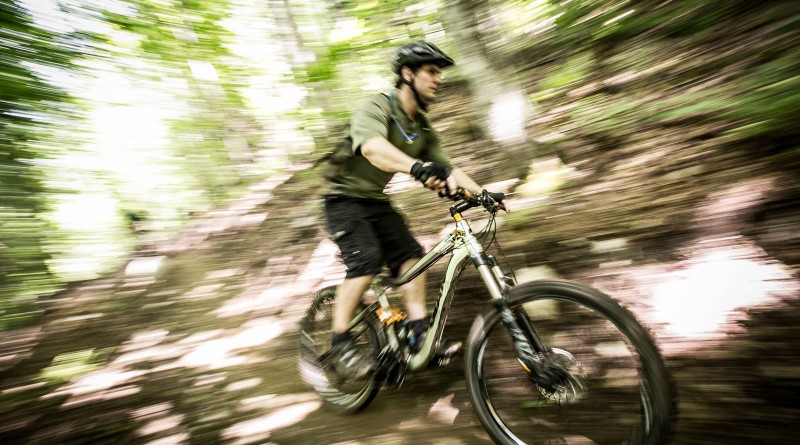All For One – Vermont Mountain Biking Association rolls out new membership management, expands statewide trail access

MONTPELIER, Vt. — Vermont’s mountain biking community took a giant pedal stroke forward this past month with a commitment to create a statewide trail system.
The break-through came when the Vermont Mountain Bike Association launched a new membership platform in early March that integrates the state’s 15 regional mountain bike chapters — which had operated independently with separate due structures — into a single annual membership. The hope is that it creates a united front with greater resources and greater trail access at a modest annual fee.
Tom Stuessy, executive director for VMBA, says he’s excited.
“The new membership platform means all riders will pay the same for membership and have access to legal trails throughout Vermont,” he says. “Most importantly, it means significantly more and better riding opportunities for riders through a robust trail grant that is built through riders’ participation in membership.”
In short, more money into a statewide pool will help develop trails throughout the state.
Starting with the March 5 announcement, statewide VMBA membership, which also includes basic local chapter benefits and other perks, will be $49 a year; though some chapters also have higher premium programs that add to that fee for added value.
Stuessy says the new structure will help break through what he calls a “membership ceiling” that has seen some chapters plateau after years of growth.
“Chapters are loving it,” he says of the response to the new system. “Lots of the larger chapters have seen steady membership numbers in recent years (but little growth). This new model ensures all chapters enjoy growth as riding develops in all areas of the state.”
Local chapters, Stuessy explained, work to create agreements with landowners that permit access to the trails as well as provide maps and directions. There are more than 800 miles of trails in the state, the majority of which are on privately owned land. About 150 to 200 miles are maintained on public lands. Additional chapters are in development, which, Stuessy says, could be added to the statewide system when and if they have the infrastructure to support more traffic.
In Chittenden County, Fellowship of The Wheel (FOT) is one chapter affected by the new plan. FOT is the largest chapter in the state, with 650-700 members and a trail network within the towns of Hinesburg, Essex and Colchester. Dana Allen, a board member for FOT, says the new membership policy adds value to their existing membership models. FOT currently offers a two-tiered membership system — a base-level membership, and a more advanced level that offers day passes to “pay-to-play” trail areas, including the Catamount Outdoor Family Center in Williston, Kingdom Trails in East Burke, Trapp Family Lodge in Stowe, and Millstone Trails in Barre.
“We just gained a ton of value, and the price didn’t increase by much,” he says. “We’re hoping that with the new membership structure, other riders throughout the state will look at the benefits that we offer with our multiple trail passes and consider joining. Even though they may not be a Chittenden County rider, the benefits are there in terms of the sheer number of trails you can ride for a relatively low price.”
Allen says he’s looking forward to trying out new trails he previously hasn’t ridden, but more importantly, he says VMBA’s move helps unify the voices of riders around the state.
“We really need access to state government,” he explained. “We really need acceptance on a state level of mountain biking as a valid recreational pursuit to get access to funding and policies that don’t lock us out of state or federal land.”
With the increase in demand for access comes the need for corresponding policies. As a result, state and federal land managers have partnered with groups like VMBA to collaborate on issues of access.
Craig Whipple, Director for State Parks, says the department’s partnership with VMBA is a new, collaborative approach to public land management.
“We tend to manage land by parcel, not by activity,” he says. “This is the first time that we’re tackling a planning effort by a particular activity parallel to our parcel-by-parcel planning. Mountain biking is so big and now we have the capacity for it grow in a reasonable, systematic way.”
VMBA and the department are in the early stages of planning a 10-year expansion of mountain biking on state land.
While benefitting riders and the trails they use, Megan Smith, State Commissioner of Tourism and Marketing, says having a unified voice for riders is also good for enticing more visitors to the state. While Vermont’s tourism industry makes the lion’s share of its revenue every year during the ski season, Smith says there’s plenty of room to expand the Vermont “brand” as a leader in outdoor recreation with mountain biking. In the summer, Smith says, the biggest draw for outdoor recreation firmly remains hiking, but with the help of VMBA, she intends to add mountain biking to that list.
“Right now, we’re focused on finding appropriate partners who can create a product we can market,” she says, adding that VMBA is leading the way within the mountain biking community.
Matt Baatz, trail manager for the Green Mountain Trails in Pittsfield, describes the new system as a great option for smaller chapters that are just getting started.
Operating in a town of 400 people makes for a small core group of local riders, he says, even though the territory the chapter has staked out at Green Mountain Trails boasts 25 miles of maintained trails. Baatz says while the network of trails is fairly large, the number of people available to help maintain the trails is small – no more than a dozen. The group relies on volunteers to help out with trail maintenance and Baatz says he is looking forward to using his relationship with VMBA to help garner more volunteers and new members.
“I’m a little starved in terms of resources and volunteers,” he says. “But I can use the strength of a statewide organization to help my cause and then use that exposure to help bring in new members.”
In addition to being able to ride all over the state under one fee structure, he adds that the new policy will help him better manage his time.
“Since we have such a low number of people, I have to wear many hats,” he says. “This (VMBA’s plan) takes away a lot of administrative and marketing burden so I can work on trails or whatever I need to do to keep the trail system thriving.”
And, as his network looks to expand in trails and members, Baatz says he’ll be able to rely on VMBA for help in the form of grants available to newer chapters.
“We’re a budding system and we’ll grow,” he says. “But as we continue to do that, it helps to have this sort of support.”
Stuessy also says the new model will help newer chapters gain more access to land upon which to build trails.
“Every chapter is fueled by volunteers and one of the trickiest, most time-consuming parts of being a new chapter is finding access to begin trail projects. If we’re able to put new chapters on state land, they automatically have a long-term partner in stewarding a fresh new trail network in partnership with a district forest parks and recreation coordinator.”
Once new chapters have trails, attracting riders — and their membership dues – is the next step.
“Access to state land for a small chapter allows the chapter to map, announce and advertise where their trail network exists,” Stuessy continued. “Because they’re on state land, it’s open for pubic use. Riders are great at recognizing the hard work of chapters. As riders fall in love with new trails, they are more likely to support the work of multiple chapters and see the value of membership.”
It’s that coming full-circle — from providing trail access to a growing membership base — that will ultimately keep VMBA growing and thriving, Stuessy says, adding that at the core of the move was the basic principle that “every rider loves a new trail.”



Pingback: Moosalamoo! - Vermont Sports Magazine